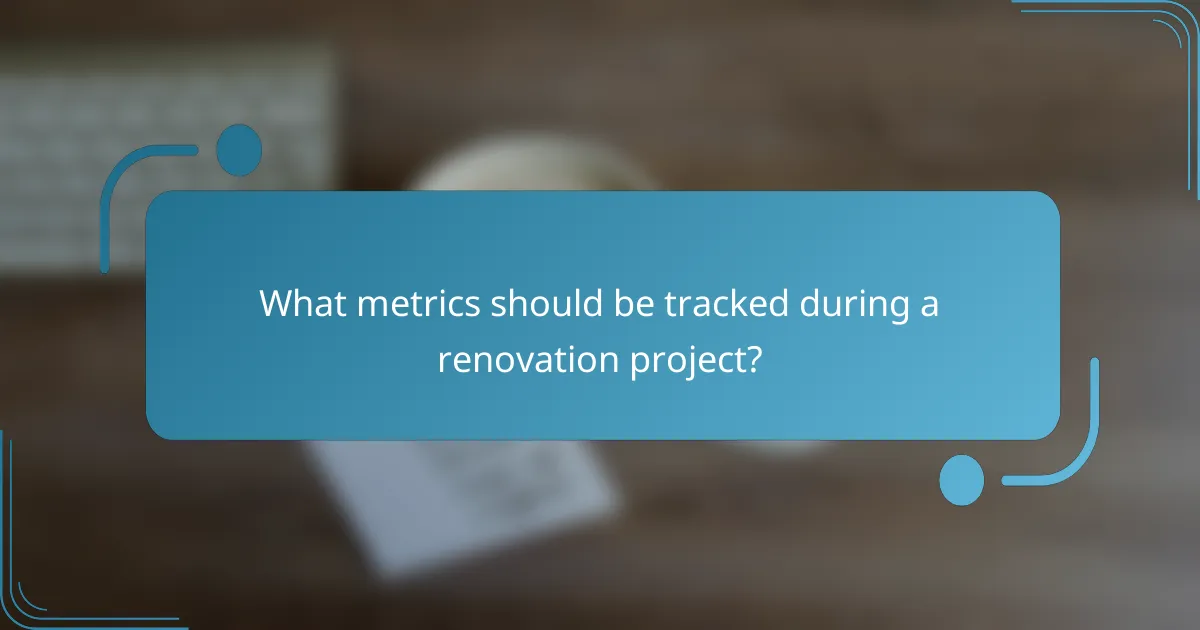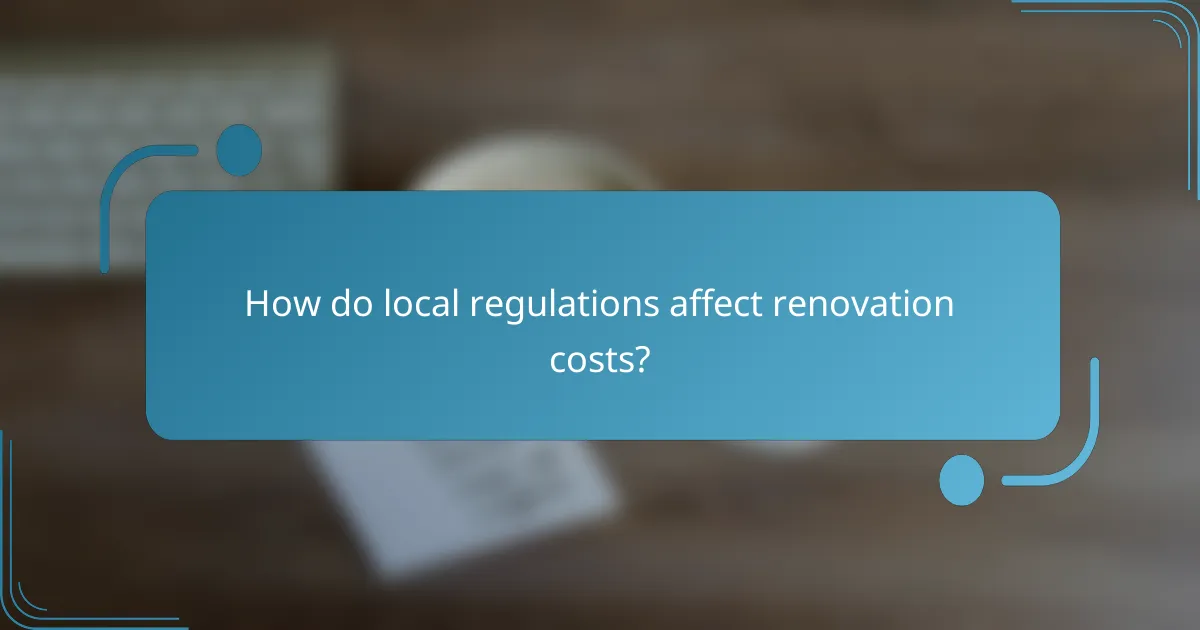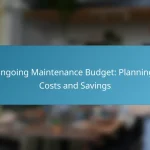Home renovation projects can often exceed initial budgets due to various unforeseen factors, making it crucial for homeowners to understand the potential causes of cost overruns. By implementing strategic planning, hiring qualified professionals, and monitoring key metrics, homeowners can effectively manage their renovation expenses and minimize unexpected financial burdens.

What are the common causes of home renovation cost overruns?
Home renovation cost overruns often stem from a variety of factors that can disrupt initial budgets. Understanding these causes can help homeowners better prepare and manage their renovation projects.
Unexpected structural issues
Unexpected structural issues, such as hidden water damage or outdated electrical systems, can significantly increase renovation costs. When walls are opened up, previously concealed problems may come to light, necessitating additional repairs and materials.
To mitigate this risk, consider conducting a thorough inspection before starting renovations. Hiring a qualified inspector can help identify potential issues early, allowing for more accurate budgeting.
Inaccurate initial estimates
Inaccurate initial estimates can lead to significant cost overruns. These estimates may overlook essential elements like permits, materials, or labor, resulting in a budget that doesn’t reflect the true scope of the project.
To avoid this pitfall, obtain multiple quotes from contractors and ensure that all aspects of the project are included in the estimates. This practice can provide a more realistic financial picture and help prevent surprises later on.
Changes in project scope
Changes in project scope, whether initiated by the homeowner or due to unforeseen circumstances, can drive costs up. Adding new features or altering designs mid-project often requires additional materials and labor, increasing the overall budget.
To manage scope changes effectively, establish a clear plan and stick to it as much as possible. If changes are necessary, assess their impact on the budget before proceeding.
Delays in material supply
Delays in material supply can disrupt timelines and inflate costs. When materials are not delivered on schedule, contractors may need to pause work, leading to additional labor costs and extended project durations.
To minimize delays, order materials well in advance and confirm availability with suppliers. Having a backup plan for alternative materials can also help keep the project on track.
Labor cost increases
Labor cost increases can occur due to market fluctuations or a shortage of skilled workers. As demand for renovations rises, labor rates may increase, impacting the overall project budget.
To manage labor costs, consider scheduling renovations during off-peak seasons when rates may be lower. Additionally, negotiate contracts with clear terms regarding labor costs to avoid unexpected increases.

How can homeowners prevent cost overruns in renovations?
Homeowners can prevent cost overruns in renovations by establishing a clear budget, planning meticulously, hiring qualified contractors, and setting aside a contingency fund. These steps help manage expenses and reduce the likelihood of unexpected costs during the renovation process.
Set a realistic budget
Creating a realistic budget is essential for avoiding cost overruns. Start by researching average costs for materials and labor in your area, and consider including a buffer for unexpected expenses, typically around 10-20% of the total budget.
Break down the budget into specific categories such as materials, labor, permits, and design fees. This detailed approach helps identify potential overspending areas and allows for better financial tracking throughout the project.
Conduct thorough planning
Thorough planning is crucial to ensure that every aspect of the renovation is considered. Develop a detailed project timeline that includes all phases of the renovation, from design to completion, and account for potential delays.
Consult with professionals to create accurate plans and specifications. This clarity can prevent costly changes and rework later in the project. Use tools like project management software to keep everything organized and on track.
Hire reputable contractors
Hiring reputable contractors can significantly reduce the risk of cost overruns. Research potential contractors by checking reviews, asking for references, and verifying their licenses and insurance. A reliable contractor will provide accurate estimates and adhere to the agreed-upon budget.
Get multiple quotes and compare them not just on price but also on the scope of work and timelines. A slightly higher bid from a well-reviewed contractor may save money in the long run by avoiding delays and additional costs.
Establish a contingency fund
Establishing a contingency fund is a smart strategy to manage unforeseen expenses during renovations. Aim to set aside at least 10-20% of your total budget for this purpose. This fund acts as a financial cushion for unexpected repairs or upgrades that may arise.
Communicate with your contractor about potential risks that could lead to additional costs, such as structural issues or outdated electrical systems. Understanding these risks can help you allocate your contingency fund more effectively and avoid financial strain.

What metrics should be tracked during a renovation project?
Tracking key metrics during a renovation project helps ensure that it stays on budget, on schedule, and meets quality standards. The primary metrics to monitor include budget adherence, timeline milestones, quality of work, and change order frequency.
Budget adherence
Budget adherence measures how closely the renovation expenses align with the planned budget. It’s crucial to regularly compare actual spending against the budgeted amounts to identify any discrepancies early on.
To maintain budget adherence, consider implementing a tracking system that categorizes expenses. This can include materials, labor, and unexpected costs. Aim to keep overall spending within a range of 5-10% of the original budget to avoid significant overruns.
Timeline milestones
Timeline milestones are specific points in the renovation schedule that indicate progress. Tracking these milestones helps ensure that the project is completed on time and allows for adjustments if delays occur.
Establish clear milestones at the start of the project, such as the completion of demolition, framing, and finishing work. Regularly review progress against these milestones and adjust the schedule as necessary to stay on track.
Quality of work
The quality of work metric assesses how well the renovation meets established standards and client expectations. High-quality work reduces the likelihood of costly repairs or rework later on.
To evaluate quality, conduct regular inspections and solicit feedback from contractors and clients. Consider using a checklist to ensure that all aspects of the work meet required standards, such as local building codes and design specifications.
Change order frequency
Change order frequency tracks how often modifications to the original plan occur during the renovation. High change order frequency can indicate poor planning or miscommunication, leading to increased costs and delays.
Minimize change orders by thoroughly planning the project before starting and ensuring all stakeholders are aligned on the scope. If changes are necessary, document them clearly and assess their impact on budget and timeline before proceeding.

How do local regulations affect renovation costs?
Local regulations significantly impact renovation costs by imposing requirements such as permits, inspections, and compliance with zoning laws. These factors can add to the overall budget and timeline of a project, making it essential for homeowners to understand the local landscape before beginning renovations.
Permit fees in California
In California, permit fees can vary widely depending on the type and scope of the renovation. For example, simple projects like interior remodels may incur fees in the low hundreds of USD, while larger projects such as additions can cost thousands. Homeowners should check with their local building department to obtain accurate estimates and understand any additional costs related to inspections.
It’s also important to factor in potential delays caused by the permitting process, which can take several weeks to months. Planning ahead and applying for permits early can help avoid costly project overruns.
Impact of zoning laws
Zoning laws dictate how properties can be used and developed, which can directly affect renovation costs. For instance, restrictions on building height, density, or land use can limit what homeowners can do, potentially leading to redesigns that increase expenses. Understanding these regulations is crucial for effective planning.
Homeowners should consult local zoning ordinances before starting renovations to ensure compliance and avoid fines. Engaging with a local architect or contractor familiar with zoning laws can provide valuable insights and help navigate any complexities that may arise during the renovation process.

What are the financial implications of cost overruns?
Cost overruns can significantly impact your renovation budget, leading to unexpected financial strain. These overruns may result in increased borrowing, reduced home equity, and potential long-term financial repercussions.
Increased loan amounts
When renovation costs exceed initial estimates, homeowners often need to secure additional financing. This can lead to increased loan amounts, which may result in higher monthly payments and extended repayment periods.
For example, if a renovation project initially budgeted at $50,000 escalates to $70,000, homeowners might need to borrow an additional $20,000. This increase can affect your debt-to-income ratio, potentially impacting future borrowing capacity.
Impact on home equity
Cost overruns can diminish the equity you build in your home. If the renovation does not add proportional value, the increased debt may outweigh the home’s market value, leading to a negative equity situation.
For instance, if you invest $70,000 into renovations but the home’s value only increases by $50,000, you could find yourself in a position where you owe more than the property is worth. This scenario can limit your options for refinancing or selling the home in the future.








